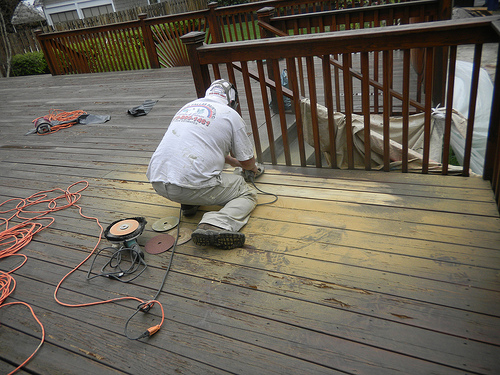To ensure your decking investment stays beneficial to you as a homeowner, you must make sure the value added to your home by installing the decking does not go down. This can occur due to molding, splintering, mildew and irreversible staining. Such problems will make your deck and your home a less desirable buy. This will actually mean that you have lost on your investment for the deck installation, which can be avoided in simple steps.
Decking is an amazing way to personalize a home and give it a little push up the market price ladder. As an extension of living space, decks make for an enticing addition to a house as they provide so many aesthetic and utility advantages. These include the charm of the rich-looking wood lumber and the quaintness it gives the home, the availability of a spot outside the home to enjoy sunsets/dawns/meals near the garden, a porch on which to sit and get fresh air without having to walk across a lawn. In order to make sure no loss is incurred while enjoying such privileges, the following rot and stain prevention steps must be followed:
Make sure your deck is clean

Particularly during spring, layers of dirt, dead bugs – and their droppings – and even wasting plant bits can amass themselves on your decking. To avoid the rot and mildew such occurrences may result in, follow these steps to clean your deck.
• Remove rubble – all kinds of plant remains, little rocks, dried mud, and etc. may find themselves lodging between your decking’s boards. Using a small, blunt knife, pull the debris out.
• Cover surrounding shrubs or plants to keep them safe from washing chemicals.
• Sweep the deck and make sure no amount of dust or rubble is left on it.
• Use the cleanser that matches the material of your deck: wood decks require standard cleaners, composite decks require cleaning products specifically aimed at composite decking and PVC decks only require warm water and a bit of soap. Should some greasy stains be tough to remove, gentle brushing with a standard degreaser or detergent will do the trick.
• Start the washing by using the tool that is most appropriate for your form of decking: a paint-roller is ideal for wood decking (be gentle with the cleaner and make sure it does not sit there for long), a soft brush for composite decks and a stiff broom for PVC decks.
To make sure your deck is given the time to dry properly, ensure you set your cleaning for a day with mild sun as hot weather may rush the cleaner’s evaporation.
Apply a sealer or toner to your deck at least once a year
Sealers, toners and stains will rejuvenate and strengthen your decking, preventing its slow weathering. They are bought as gallons (each covering 250sq ft. of your deck) and need to be applied over, as with polish, on the boards. Several options of sealer/toner/stain are available, each providing a different finish effect on your deck. If you live in a particularly sunny area, a toner with UV light protection may be the best choice.
They also come with a slight color tint that adds a natural-looking plump of color to your decking while being transparent enough to let the grainage show through. For areas with lower risk of over exposure to sunlight, a stain is available with the same tinting agents but with no UV light protection. To completely cover your decking, solid-colored stain is available. This will cover weathering damage, but it also will render the grainage barely discernable.
As with the cleaning of your deck, it is advisable to do to apply your stain or toner when the temperatures range on average as it is imperative the product does not dry too fast. Similarly, you need to make sure there is no chance of rain as rainfall will dilute the product with dirty or even acid water. For the best effect, ensure you apply a couple of coats, making each as light as possible. This will guarantee better absorption of the liquid. As with washing a wooden deck, ideal application of the toner or stain is achieved with a paint roller. You should note that a composite deck does not require sealing.
Damage prevention and repair
It is crucial to perform a thorough inspection of your decking at least once a year. This is to make sure no crack, weathering or rot is left unattended. To check whether a certain spot on your decking has rot, push a screwdriver into it. Should it go down deeper than two centimeters, the boards are most likely rotting. If that is the case, it is unnecessary to panic, as this is easily fixable. Contact a carpenter to receive advice on what ought to be done and to get an estimate or quote of what the repairs will cost.
Sometimes, even if you have tried to maintain your decks well, replacement is an inevitable option. If you need to get new wood, composite or PVC decking in Edmonton, do contact us today as we will be able to install new decks for you at a cheaper price by considering how much we can salvage from your old decks.